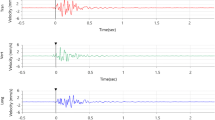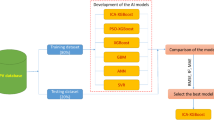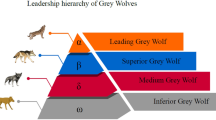Abstract
Ground vibration is one of the most undesirable effects induced by blasting operations in open-pit mines, and it can cause damage to surrounding structures. Therefore, predicting ground vibration is important to reduce the environmental effects of mine blasting. In this study, an eXtreme gradient boosting (XGBoost) model was developed to predict peak particle velocity (PPV) induced by blasting in Deo Nai open-pit coal mine in Vietnam. Three models, namely, support vector machine (SVM), random forest (RF), and k-nearest neighbor (KNN), were also applied for comparison with XGBoost. To employ these models, 146 datasets from 146 blasting events in Deo Nai mine were used. Performance of the predictive models was evaluated using root-mean-squared error (RMSE) and coefficient of determination (R2). The results indicated that the developed XGBoost model with RMSE = 1.554, R2 = 0.955 on training datasets, and RMSE = 1.742, R2 = 0.952 on testing datasets exhibited higher performance than the SVM, RF, and KNN models. Thus, XGBoost is a robust algorithm for building a PPV predictive model. The proposed algorithm can be applied to other open-pit coal mines with conditions similar to those in Deo Nai.







Similar content being viewed by others
Change history
23 March 2021
A Correction to this paper has been published: https://doi.org/10.1007/s11600-021-00575-9
References
Ak H, Konuk A (2008) The effect of discontinuity frequency on ground vibrations produced from bench blasting: a case study. Soil Dynamics and Earthquake Engineering 28:686–694
Alnaqi AA, Moayedi H, Shahsavar A, Nguyen TK (2019) Prediction of energetic performance of a building integrated photovoltaic/thermal system thorough artificial neural network and hybrid particle swarm optimization models. Energy Convers Manag 183:137–148
Altman NS (1992) An introduction to kernel and nearest-neighbor nonparametric regression. The American Statistician 46:175–185
Ambraseys NR, Hendron AJ (1968) Dynamic behavior of rock masses. In: Stagg KG, Zienkiewicz OC (eds) Rock mechanics in engineering practices. Wiley, New York, pp 203–207
Breiman L (2001) Random forests. Mach Learn 45:5–32
Bui X-N, Nguyen H, Le H-A, Bui H-B, Do N-H (2019) Prediction of blast-induced air over-pressure in open-pit mine: assessment of different artificial intelligence. Tech Natl Resour Res. https://doi.org/10.1007/s11053-019-09461-0
Chandar KR, Sastry V, Hegde C (2017) A critical comparison of regression models and artificial neural networks to predict ground vibrations. Geotech Geol Eng 35:573–583
Chen T, He T (2015) Xgboost: extreme gradient boosting R package version 04-2
Chen G, Huang SL (2001) Analysis of ground vibrations caused by open pit production blasts–a case study. Fragblast 5(1–2):91–107
Cortes C, Vapnik V (1995) Support-vector networks. Mach Learn 20:273–297
Coursen DL (1995) Method of reducing ground vibration from delay blasting. Google Patents
Davies B, Farmer I, Attewell P (1964) Ground vibration from shallow sub-surface blasts. Engineer 217(5644):553–559
Drucker H, Burges CJ, Kaufman L, Smola AJ, Vapnik V (1997) Support vector regression machines. In: Advances in neural information processing systems, pp 155–161
Duvall WI, Fogelson DE (1962) Review of criteria for estimating damage to residences from blasting vibrations. US Department of the Interior, Bureau of Mines
Faradonbeh RS, Monjezi M (2017) Prediction and minimization of blast-induced ground vibration using two robust meta-heuristic algorithms. Eng Comput 33(4):835–851. https://doi.org/10.1007/s00366-017-0501-6
Faradonbeh RS, Armaghani DJ, Majid MA, Tahir MM, Murlidhar BR, Monjezi M, Wong H (2016) Prediction of ground vibration due to quarry blasting based on gene expression programming: a new model for peak particle velocity prediction. Int J Environ Sci Technol 13:1453–1464
Friedman JH (2001) Greedy function approximation: a gradient boosting machine. Ann Stat 29(5):1189–1232
Friedman JH (2002) Stochastic gradient boosting. Comput Stat Data Anal 38:367–378
Friedman J, Hastie T, Tibshirani R (2000) Additive logistic regression: a statistical view of boosting (with discussion and a rejoinder by the authors). Ann Stat 28:337–407
Friedman J, Hastie T, Tibshirani R (2001) The elements of statistical learning vol 1. vol 10. Springer series in statistics New York, NY, USA
Gad EF, Wilson JL, Moore AJ, Richards AB (2005) Effects of mine blasting on residential structures Journal of performance of constructed facilities 19:222–228
Gao W, Dimitrov D, Abdo H (2018a) Tight independent set neighborhood union condition for fractional critical deleted graphs and ID deleted graphs. Discrete Continuous Dyn Syst S 123–144. https://doi.org/10.3934/dcdss.2019045
Gao W, Guirao JL, Basavanagoud B, Wu J (2018b) Partial multi-dividing ontology learning algorithm. Inf Sci 467:35–58
Gao W, Guirao JLG, Abdel-Aty M, Xi W (2018c) An independent set degree condition for fractional critical deleted graphs. Discrete Continuous Dyn Syst S 12:877–886. https://doi.org/10.3934/dcdss.2019058
Gao W, Wang W, Dimitrov D, Wang Y (2018d) Nano properties analysis via fourth multiplicative ABC indicator calculating. Arab J Chem 11:793–801
Gao W, Wu H, Siddiqui MK, Baig AQ (2018e) Study of biological networks using graph theory. Saudi J Biol Sci 25:1212–1219
Ghasemi E, Ataei M, Hashemolhosseini H (2013) Development of a fuzzy model for predicting ground vibration caused by rock blasting in surface mining. J Vib Control 19:755–770
Ghasemi E, Kalhori H, Bagherpour R (2016) A new hybrid ANFIS–PSO model for prediction of peak particle velocity due to bench blasting. Eng Comput 32:607–614
Hajihassani M, Armaghani DJ, Sohaei H, Mohamad ET, Marto A (2014) Prediction of airblast-overpressure induced by blasting using a hybrid artificial neural network and particle swarm optimization. Appl Acoust 80:57–67
Hajihassani M, Armaghani DJ, Marto A, Mohamad ET (2015) Ground vibration prediction in quarry blasting through an artificial neural network optimized by imperialist competitive algorithm. Bull Eng Geol Environ 74:873–886
Hasanipanah M, Monjezi M, Shahnazar A, Armaghani DJ, Farazmand A (2015) Feasibility of indirect determination of blast induced ground vibration based on support vector machine. Measurement 75:289–297
Hasanipanah M, Armaghani DJ, Amnieh HB, Majid MZA, Tahir MM (2017a) Application of PSO to develop a powerful equation for prediction of flyrock due to blasting. Neural Comput Appl 28:1043–1050
Hasanipanah M, Faradonbeh RS, Amnieh HB, Armaghani DJ, Monjezi M (2017b) Forecasting blast-induced ground vibration developing a CART model. Eng Comput 33:307–316
Hasanipanah M, Golzar SB, Larki IA, Maryaki MY, Ghahremanians T (2017c) Estimation of blast-induced ground vibration through a soft computing framework. Eng Comput 33(4):951–959. https://doi.org/10.1007/s00366-017-0508-z
Hu C, Jain G, Zhang P, Schmidt C, Gomadam P, Gorka T (2014) Data-driven method based on particle swarm optimization and k-nearest neighbor regression for estimating capacity of lithium-ion battery. Appl Energy 129:49–55
Longjun D, Xibing L, Ming X, Qiyue L (2011) Comparisons of random forest and support vector machine for predicting blasting vibration characteristic parameters. Procedia Eng 26:1772–1781
Moayedi H, Nazir R (2018) Malaysian experiences of peat stabilization, state of the art. Geotech Geol Eng 36:1–11
Moayedi H, Rezaei A (2017) An artificial neural network approach for under-reamed piles subjected to uplift forces in dry sand. Neural Comput Appl. https://doi.org/10.1007/s00521-017-2990-z
Moayedi H, Raftari M, Sharifi A, Jusoh WAW, Rashid ASA (2019) Optimization of ANFIS with GA and PSO estimating α ratio in driven piles. Eng Comput. https://doi.org/10.1007/s00366-018-00694-w
Monjezi M, Bahrami A, Varjani AY, Sayadi AR (2011a) Prediction and controlling of flyrock in blasting operation using artificial neural network. Arab J Geosci 4:421–425
Monjezi M, Ghafurikalajahi M, Bahrami A (2011b) Prediction of blast-induced ground vibration using artificial neural networks. Tunn Undergr Space Technol 26:46–50
Monjezi M, Hasanipanah M, Khandelwal M (2013) Evaluation and prediction of blast-induced ground vibration at Shur River Dam, Iran, by artificial neural network. Neural Comput Appl 22:1637–1643
Nguyen H, Bui X-N (2018a) A comparison of artificial neural network and empirical technique for predicting blast-induced ground vibration in open-pit mine. In: Mining sciences and technology—XXVI, Mong Cai, Hanoi, Vietnam. Industry and trade of the socialist Republic of Vietnam, pp 177–182
Nguyen H, Bui X-N (2018b) Predicting blast-induced air overpressure: a robust artificial intelligence system based on artificial neural networks and random forest. Natl Resour Res. https://doi.org/10.1007/s11053-018-9424-1
Nguyen H, Bui X-N, Bui H-B, Mai N-L (2018a) A comparative study of artificial neural networks in predicting blast-induced air-blast overpressure at Deo Nai open-pit coal mine, Vietnam. Neural Comput Appl. https://doi.org/10.1007/s00521-018-3717-5
Nguyen H, Bui X-N, Tran Q-H, Le T-Q, Do N-H, Hoa LTT (2018b) Evaluating and predicting blast-induced ground vibration in open-cast mine using ANN: a case study in Vietnam SN. Appl Sci 1:125. https://doi.org/10.1007/s42452-018-0136-2
Nguyen H, Bui X-N, Tran Q-H, Mai N-L (2019) A new soft computing model for estimating and controlling blast-produced ground vibration based on hierarchical k-means clustering and cubist algorithms. Appl Soft Comput. https://doi.org/10.1016/j.asoc.2019.01.042
Protodiakonov M, Koifman M, Chirkov S, Kuntish M, Tedder R (1964) Rock strength passports and methods for their determination. Nauka, Moscow
Roy PP (1991) Prediction and control of ground vibration due to blasting. Colliery Guard 239:215–219
Saadat M, Khandelwal M, Monjezi M (2014) An ANN-based approach to predict blast-induced ground vibration of Gol-E-Gohar iron ore mine. Iran J Rock Mech Geotech Eng 6:67–76
Sheykhi H, Bagherpour R, Ghasemi E, Kalhori H (2018) Forecasting ground vibration due to rock blasting: a hybrid intelligent approach using support vector regression and fuzzy C-means clustering. Eng Comput 34(2):357–365. https://doi.org/10.1007/s00366-017-0546-6
Standard I (1973) Criteria for safety and design of structures subjected to under ground blast ISI, IS-6922
Taheri K, Hasanipanah M, Golzar SB, Majid MZA (2017) A hybrid artificial bee colony algorithm-artificial neural network for forecasting the blast-produced ground vibration. Eng Comput 33:689–700
Vigneau E, Courcoux P, Symoneaux R, Guérin L, Villière A (2018) Random forests: a machine learning methodology to highlight the volatile organic compounds involved in olfactory perception. Food Qual Prefer 68:135–145
Vinacomin (2015) Report on geological exploration of Coc Sau open pit coal mine, Quang Ninh, Vietnam (in Vietnamse-unpublished). VINACOMIN, Vietnam
Zorlu K, Gokceoglu C, Ocakoglu F, Nefeslioglu H, Acikalin S (2008) Prediction of uniaxial compressive strength of sandstones using petrography-based models. Eng Geol 96:141–158
Acknowledgements
We would like to thank the Hanoi University of Mining and Geology (HUMG), Vietnam; Ministry of Education and Training of Vietnam (MOET); The Center for Mining, Electro-Mechanical research of HUMG.
Author information
Authors and Affiliations
Corresponding author
Ethics declarations
Conflict of interest
On behalf of all authors, I hereby attest that no conflict of interest exists in financial relationships, intellectual property, or any point related to publishing ethics.
Rights and permissions
About this article
Cite this article
Nguyen, H., Bui, XN., Bui, HB. et al. Developing an XGBoost model to predict blast-induced peak particle velocity in an open-pit mine: a case study. Acta Geophys. 67, 477–490 (2019). https://doi.org/10.1007/s11600-019-00268-4
Received:
Accepted:
Published:
Issue Date:
DOI: https://doi.org/10.1007/s11600-019-00268-4




